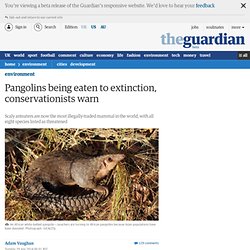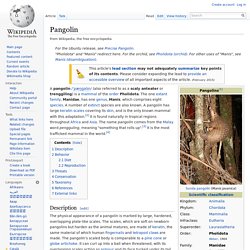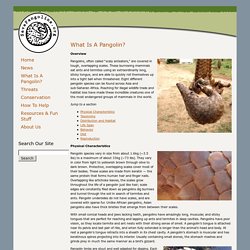

Critically endangered pangolins rescued, then sold as food. In some of the more bizarre food news this month: Police in Vietnam’s northern Bac Ninh province recently seized 42 live, critically endangered Sunda Pangolins from poachers, fined the culprits, and delivered the animals to forest rangers for safekeeping—at which point those forest rangers proceeded to undo all this valiant action by selling the animals off to local restaurants.

They secured almost $12,000 for the illegal meat, leaving the creatures to have their tongues cut out and their scales plucked off. That’s the fate of poached pangolins, also known as ‘scaly anteaters’. Although, perhaps surprisingly, many people don’t seem to know what these creatures are, the prehistoric-looking mammals feel the brunt of a trade that makes them the world’s most trafficked mammals on earth, says the International Union for Conservation of Nature (IUCN). That brings us back to the Vietnamese officials who capitalised on that appetite instead of trying to plug it. But there’s also room for hope. Pangolins being eaten to extinction, conservationists warn. Pangolins are being "eaten to extinction" due to a demand for their meat at banquets in China and Vietnam and their scales for use in Chinese medicine, conservationists have warned.

In an update last week to the authoritative Red List of endangered animals, all eight species of the scaly anteaters were upgraded to threatened status. Resembling a pine cone on legs, they are the world's only scaly mammal, using their scales for armour to protect against predators and their long, sticky tongues to catch prey. According to experts at the Zoological Society of London, the demand for the animals in Asia has been so great that poachers are now turning to Africa, where four of the species are found. Conservationists say there is already evidence of an underground, intercontinental trade in pangolins between Africa and Asia. The four African species, which were previously listed as "least concern" or "near threatened" are now all classed as the more serious "vulnerable" listing. Pangolin. What’s scaly from tip to tail and can curl into a ball?

Pangolins! These solitary, primarily nocturnal animals, are easily recognized by their full armor of scales. A startled pangolin will cover its head with its front legs, exposing its scales to any potential predator. If touched or grabbed it will roll up completely into a ball, while the sharp scales on the tail can be used to lash out. Also called scaly anteaters because of their preferred diet, pangolins are increasingly victims of illegal wildlife crime—mainly in Asia and in growing amounts in Africa—for their meat and scales. Eight species of pangolins are found on two continents. Four species live in Africa: Black-bellied pangolin (Phataginus tetradactyla), White-bellied pangolin (Phataginus tricuspis), Giant Ground pangolin (Smutsia gigantea) and Temminck's Ground pangolin (Smutsia temminckii). Pangolin. Description[edit] Pangolins can also emit a noxious-smelling acid from glands near the anus, similar to the spray of a skunk.

Pangolins, though, are not able to spray this acid as skunks do. [citation needed] They have short legs, with sharp claws which they use for burrowing into termite and ant mounds, as well as climbing. [citation needed] What Is A Pangolin? Overview Pangolins, often called “scaly anteaters,” are covered in tough, overlapping scales.

These burrowing mammals eat ants and termites using an extraordinarily long, sticky tongue, and are able to quickly roll themselves up into a tight ball when threatened. Eight different pangolin species can be found across Asia and sub-Saharan Africa. Poaching for illegal wildlife trade and habitat loss have made these incredible creatures one of the most endangered groups of mammals in the world.
Jump to a section Physical Characteristics Pangolin species vary in size from about 1.6kg (~3.5 lbs) to a maximum of about 33kg (~73 lbs). With small conical heads and jaws lacking teeth, pangolins have amazingly long, muscular, and sticky tongues that are perfect for reaching and lapping up ants and termites in deep cavities. Pangolin limbs are stout and well adapted for digging.
Taxonomy There are eight pangolin species. Asian pangolins: African pangolins: Distribution and Habitat Life Span Behavior Diet. Advisory-on-pangolin.